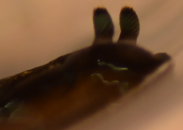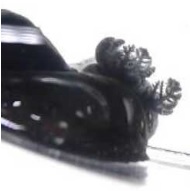The Sensory
System
The majority of
nudibranchs come in a dazzling array of colours and patterns but nudibranchs
themselves cannot discern image or colours (Behrens et al., 2005). Rather, there is evidence
that they have primitive eye tissue, usually a pigment spot imbedded anteriorly,
which is sensitive to light. In terms of finding their way around, the
nudibranchs are believed to employ a sense of touch through head/oral tentacles
(Behrens et al., 2005). Aeolid nudibranchs,
characterised by their dorsal cerata, extend and wave their head tentacles for guidance
as they move and it is thought that
dorids do this with the cylindrical feeders on the sides of their mouth in a
similar manner. However, rhinophores are also used extensively in reading the
environment and locating food (Figure 1) .
|

|
|
Figure 1: The Rhinophores of D.nigra. Original Photo by Elsie-Mary Felix
|
While it
is not known if nudibranchs can smell, the rhinophores can distinguish chemical
molecules in the water and are connected to the brain via large nerves (Behrens et al., 2005). Two types of cell structures
are present in these nerve endings. These include ciliated cells which sense
vibrations and changes in water pressure functioning as mechanoreceptors and
branched (dendritic) cells facilitate chemical reception. The ciliated cells
also facilitate “hearing” as the vibrations and changes in water pressure that they
detect are equivalent to sound waves in air. Nudibranchs also have octoconia or
otoliths which are thought to function as hydrostatic and gravitational
sensors. These small spherical calcareous bodies which are contained in an
organ known as the statocyst, are the evolutionary precursor to human ear bones
and don’t necessarily interpret sound but spatial orientation (Behrens et al., 2005). The dendritic cells and oral
tentacles play an important role in sensing chemical compounds released by
their prey.
Respiration
Dorid
nudibranchs, bar the phyllidids, have an “anal gill” which is easily recognised
by dorsal branchial plumes that encircle the posterior anus (Figure 2)(Brodie et al., 1997). The gills, like many other marine organisms,
extract oxygen from the seawater.
 |
|
Figure 2: The gill plume of D.nigra.
Original photo by Elsie-Mary Felix
|
Locomotion
D. nigra’s
primary mode of locomotion is crawling using its foot located on the underside
of its body (Behrens et al., 2005). The foot is made up of an
elongate inner strip of tissue (the sole) and a thicker outer band that runs
all the way around the circumference of the animal and mostly keeps in contact
with substrate (Figure 3). It is only when muscular contractions running from the head to
the tail, that pull the slug forward, does the sole make contact with the
substrate. Through powerful contractions
of the muscular outer foot the nudibranch is able to anchor itself to the
substrate while the remainder of its body is stretched forward. The outer band
can also be used to cling to irregular surfaces (Behrens et al., 2005). While muscular waves are
almost exclusively used to crawl, the secretion of a slime trail and the
beating of cilia can also be used to assist.
 |
| Figure 3: The underside of D.nigra which includes the foot and sole. |
Feeding
Nudibranchs are
carnivores with dorids having the highest number of species without hard mouth
parts (Behrens et al., 2005). Most cryptobranchs feed on
sponges and this is seen in species of Dendrodoris. D.nigra secretes digestive
enzymes onto the sponge’s surface before sucking up the resulting “stew” (Young, 1966).
Reproduction
All adult
nudibranchs are hermaphroditic with the reproductive organs of both sexes and
genital opening located on their right hand side (Behrens et al., 2005, Valdés and Gosliner, 1999). Self-fertilization cannot be
achieved so mating requires two nudibranchs align, head to tail, with their
genital openings in close proximity. As
the genital papillae of the two nudibranchs touches, the penis of each
individual enters the female duct of the other and fertilization occurs. Egg
ribbons can then be laid by each individual. Once reaching sexual maturity,
nudibranchs only have a short time to reproduce due to their relatively short
lifespan.
Predation and Defences
Not much is known
about predators of nudibranchs as it is difficult to distinguish their tissue
in stomach contents due to their lack of shell and bones (Behrens et al., 2005). Those found to consume
nudibranchs include pycnogonids, nemertean worms, crabs, starfish, some fishes
and sea turtles. However there is uncertainty associated with these predators as
it is not known whether the nudibranch was actively pursued as prey or whether
it was scavenged after death. In order
to protect themselves, nudibranchs have evolved physical and chemical defences
to compensate for the loss of their shell.
Most nudibranchs display their distastefulness through bright colours
and patterns, known as “Aposematism”; however D.nigra lacks such a
display. Rather, D.nigra’s colouration
may act as more of a camouflage to match the bottom environments. Nudibranchs
that prey on sponges have also evolved the ability to molecularly modify
deterrents they consume in sponge tissue and use it for their personal defences
by storing it in their skin and egg masses (Behrens et al., 2005).